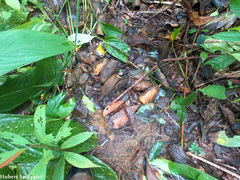

|
|
|
|
Family: Lecythidaceae
congolo, more...coquito
[Couratari panamensis Standl.] |
Description: A tall forest tree with a straight trunk, usually cylindrical, with small buttresses at the base. Bark is gray with clear vertical fissures. Leaves are simple, alternate, arranged regularly along the branches in a flat plane. Sometimes the leaves are toothed, especially in juveniles, but sometimes not. The petiole is short and has a slight channel on the upper side; there are no stipules. Reproduction: Flowers are in small terminal groups, pink, and have a dense ring holding many stamen; they are produced twice a year, in July and August and again from December to February. The fruits are very unusual -- cylindrical woody tubes about 15 cm long with a cap that fits very neatly over the opening at one end. When the cap opens, the winged seeds fall out. Distribution: Fairly common in the forests of the northern part of Soberania, and there is a dense population at the outlying wet forest near Laguna south of the Canal. Just one large individual known at Barro Colorado. Rare in the upper Chagres area, and rather surprisingly, not known at Sherman. Not seen on the Pacific slope, and not known in open areas, farmland or towns. Similar Species: Except where there are fruits on the ground, this species can be hard to spot. The alternate leaves in a flat plane are also typical in other families, and this species might be first identified as an Annonaceae when leaves are lacking teeth. In particular, LK guatdu Guatteria dumetorum LK2 has leaves rather like Couratari's. When leaves are toothed, a first identification might be Flacourtiaceae, but nothing in that family has leaves that are very similar. Look especially at the short petioles with a grooved upper surface in Couratari. Uses: The heavy wood and large size combine to make this tree sought after for its wood, but it does not typically appear in commercial markets. Descripción: Árbol de 20 a 40 m de alto. Tronco con raíces tablares de mediano tamaño en la base. Corteza exterior gris y exfoliante en láminas pequeñas. Ramitas terminales cubiertas de pelos. Hojas simples y alternas, de 8-20 x 4-10 cm, elípticas a oblongas, con ápice redondeado o cortamente acuminado, bordes enteros o a veces dentados y base redondeada. Las plantas juveniles tienen hojas lanceoladas y de mayor tamaño en comparación con los adultos. Pecíolo de 0.5-1.5 cm de largo y ligeramente acanalado en la parte superior. Flores rosadas y con los estambres arreglados en un andróforo. Frutos en pixidios tubulares y cilíndricos, de 7-12 cm de largo, con pericarpo duro y leñoso, cubiertos de lenticelas blancas en el exterior. Semillas aladas. Datos Ecológicos: La especie crece a bajas y medianas elevaciones, en lugares húmedos o muy húmedos. En Panamá se encuentra en las provincias de Bocas del Toro, Colón, Darién, Panamá y Veraguas. Común en bosques de la isla de Coiba. Deja caer parcialmente sus hojas durante la época de floración, pero las repone rápidamente. Florece y fructifica dos veces al año, de julio a septiembre, y de diciembre a marzo. Las semillas son dispersadas por el viento. Especies Parecidas: A menudo se confunde con LK coursc Couratari scottmorii LK2 , pero C. scotmorii es una especie muy rara. Usos: La madera es empleada en construcciones de puentes, postes para cercas, ebanistería, carpintería, contrachapado, molduras, mobiliario, embalajes, cajas, encofrados y entarimados. De la corteza se extraen fibras que se usan para fabricar cuerdas y hamacas. Los restos de los frutos se utilizan para hacer arreglos florales. Tree, to 40 m tall, to 75 cm or more dbh; buttresses 1-2 m high; outer bark reddish-brown, hard, moderately coarse, with weak vertical fissures; inner bark pale; wood reddish-brown, hard; stems minutely ferruginous-hirtellous, at least when young, angulate on drying. Petioles 5-15 mm long, glabrate; blades oblong to oblong-elliptic, acute to short- acuminate, obtuse to rounded at base, 5.5-18 cm long, 2-8 (10) cm wide, hirtellous to glabrate on midrib and veins, the margins irregular. Panicles terminal, bearing few to many flowers; flowers with a faint, somewhat unpleasant aroma, precocious or occurring with new leaves, sometimes on a few leafless branches while other branches fully leaved; pedicels 1.5-2.5 cm long; calyx deeply 6-lobed, the lobes imbricate, +/- ovate, obtuse; petals 6, lavender to rose, to ca 2.5 cm long, rounded at apex, often minutely fimbriate, of unequal widths, 2 petals +/- spatulate, usually broader, to 1.3 cm wide, the others narrowly oblong, to 8 mm wide; androphore produced into a prominent hood spirally involute then reversely revolute, the whole structure subglobular, slightly broader than high, to 1.7 cm wide, +/- magenta and white, the basal part of the androphore shaped like a soap dish, whitish inside, magenta on margins; stamens mostly 13-18, arranged around the stigmatic orifice, ca 1 mm long; anthers rounded, flattened, about as long as filament; ovary 3-celled; stylar orifice ca 1.5 mm diam; stigma +/- sessile, minutely 3-radiate. Capsules woody, narrowly cylindrical-campanulate pyxidia, slightly asymmetrical, brown, conspicuously lenticellate, 7-12 cm long, 3-4 cm diam, pendent at maturity; cap and the strong central placenta falling free to allow dispersal of seed through orifice; seeds several per locule, prominently winged, thin, ca 7 cm long. Croat 8061, 16507. Rare; only a few individuals known on the island. Flowers from July through August, but an individual may flower only once every two years. Allen (1956) reported flowering in late September on the Osa Peninsula in Costa Rica. The fruits mature in February and March. |











































































